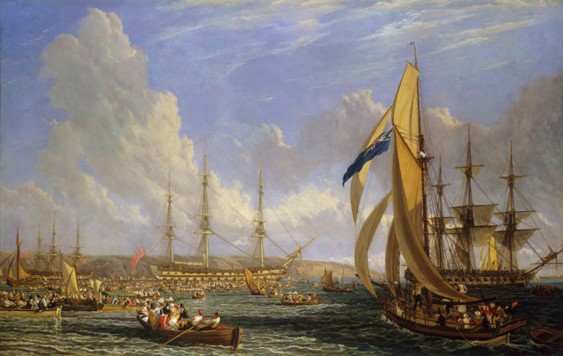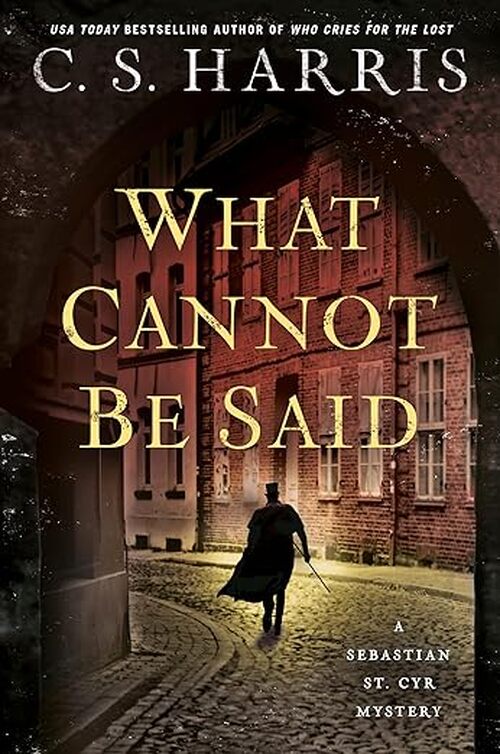The most talked-about tourist attraction in Regency England in the summer of 1815 was the deposed French emperor, Napoleon Bonaparte, who spent two weeks on a British naval ship anchored off the southern coast of Devon.
This little-known footnote in history plays out in the background of my new historical mystery-thriller, WHAT CANNOT BE SAID, in which Sebastian St. Cyr, Lord Devlin, investigates the bizarre murder of a woman and her daughter that takes place that fateful summer.
After his bloody defeat at Waterloo on the eighteenth of June, Napoleon had returned to Paris, where he abdicated in favor of his young son before retreating to Josephine’s famous Château de Malmaison. At that point Josephine, his first wife, had been dead for over a year, the house had been ransacked, and its famous gardens were dying from neglect. Napoleon’s family and supporters urged him to immediately head for the west coast and take ship to the United States—in fact, his brother Joseph successfully did just that after failing to convince Napoleon to come with him. Instead, sunk in grief and depression, Napoleon wandered the echoing empty halls and ruined gardens of Malmaison. He delayed his departure for so long that by the time he reached the Atlantic port of Rochefort, British ships had already arrived to block his exit and it was too late.
With both the Prussians and the newly restored Bourbon monarchy eager to execute him, Napoleon decided to seek asylum in Britain. And so, on a balmy summer morning in mid-July, dressed in his familiar white breeches, white waistcoat, cavalry boots, green coat, and black cocked hat, Napoleon surrendered voluntarily to the captain of HMS Bellerophon. The French soldiers and sailors who had assembled to see him off wept, then broke into a rousing chorus of Vive l’Empereur! Vive l’Empereur!
Bellerophon then set sail for Britain, where it anchored off Torbay for two days before shifting to Plymouth. No one was allowed on board, but word of Napoleon’s presence quickly spread until something like ten thousand people a day were flocking to the southern coast in the hopes of catching a glimpse of Bellerophon’s passenger. Hiring everything from yachts and fishing boats to small skiffs and row boats, the sightseers filled the harbor, with the crew putting up signs to alert the tourists to when Napoleon was next expected to show himself on deck—typically in the morning, and before and after his six o’clock dinner.
Meanwhile, the government in London was trying to decide what to do with their awkward “guest.” Napoleon himself was hoping to be allowed to retire to the quiet life of a country gentleman on a small estate somewhere in England. The Prime Minister, Liverpool, was at first in favor of turning him over to the Bourbons to hang, although he conceded that executing a deposed head of state would set a dangerous precedent. And even if one chose to simply regard Bonaparte as an enemy general rather than an emperor, the fact remained that one did not—or at least should not—kill enemy soldiers who surrendered voluntarily.
But by the end of July, Liverpool’s government finally made up its mind: they would send Napoleon into exile on the isolated, windswept Atlantic island of St. Helena.
Thus, on the fourth of August, Bellerophon left Plymouth to rendezvous with HMS Northumberland. And several days later, under gray, cloudy skies, Northumberland weighed anchor and set sail with its famous passenger for St. Helena, where he would die just a few short years later of stomach cancer.
https://upload.wikimedia.org/wikipedia/commons/5/5b/HMS_Bellerophon_and_Napoleon.jpg

WHAT CANNOT BE SAID by C.S. Harris
Sebastian St. Cyr Mystery #19
A seemingly idyllic summer picnic ends in a macabre murder that echoes a pair of slayings fourteen years earlier in this riveting new historical mystery from the USA Today bestselling author of Who Cries for the Lost.
July 1815: The Prince Regent’s grandiose plans to celebrate Napoléon’s recent defeat at Waterloo are thrown into turmoil when Lady McInnis and her daughter Emma are found brutally murdered in Richmond Park, their bodies posed in a chilling imitation of the stone effigies once found atop medieval tombs. Bow Street magistrate Sir Henry Lovejoy immediately turns to his friend Sebastian St. Cyr, Viscount Devlin, for help with the investigation. For as Devlin discovers, Lovejoy’s own wife and daughter were also murdered in Richmond Park, their bodies posed in the same bizarre postures. A traumatized ex-soldier was hanged for their killings. So is London now confronting a malicious copyist? Or did Lovejoy help send an innocent man to the gallows?
Aided by his wife, Hero, who knew Lady McInnis from her work with poor orphans, Devlin finds himself exploring a host of unsavory characters from a vicious chimney sweep to a smiling but decidedly lethal baby farmer. Also coming under increasing scrutiny is Sir Ivo McInnis himself, along with a wounded Waterloo veteran—who may or may not have been Laura McInnis’s lover—and a charismatic young violinist who moonlights as a fencing master and may have formed a dangerous relationship with Emma. But when Sebastian’s investigation turns toward man about town Basil Rhodes, he quickly draws the fury of the Palace, for Rhodes is well known as the Regent’s favorite illegitimate son.
Then Lady McInnis’s young niece and nephew are targeted by the killer, and two more women are discovered murdered and arranged in similar postures. With his own life increasingly in danger, Sebastian finds himself drawn inexorably toward a conclusion far darker and more horrific than anything he could have imagined.
Mystery Amateur Sleuth [Berkley, On Sale: April 16, 2024, Hardcover / e-Book, ISBN: 9780593639184 / eISBN: 9780593639191]
 Nobleman sleuth must uncover a chilling killer
Nobleman sleuth must uncover a chilling killer
Buy WHAT CANNOT BE SAID: Amazon.com | Kindle | BN.com | Apple Books | Kobo | Google Play | Powell’s Books | Books-A-Million | Indie BookShops | Ripped Bodice | Walmart.com | Target.com | Amazon CA | Amazon UK | Amazon DE | Amazon FR
About C.S. Harris
Candice Proctor, aka C.S. Harris and C.S. Graham, is the bestselling, award-winning author of more than a dozen novels including the Sebastian St. Cyr Regency mystery series written under the name C.S. Harris, the new C.S. Graham thriller series co-written with Steven Harris, and seven historical romances. She is also the author of a nonfiction historical study of the French Revolution. Her books are available worldwide and have been translated into over twenty different languages. Candice graduated Phi Beta Kappa, summa cum laude with a degree in Classics before going on to earn an MA and Ph.D. in history. A former academic, she has taught at the University of Idaho and Midwestern State University in Texas. She also worked as an archaeologist on a variety of sites including a Hudson’s Bay Company Fort in San Juan Island, a Cherokee village in Tennessee, a prehistoric kill site in Victoria, Australia, and a Roman cemetery and medieval manor house in Winchester, England. Most recently, she spent many years as a partner in an international business consulting firm. The daughter of a career Air Force officer and university professor, Proctor loves to travel and has spent much of her life abroad. She has lived in Spain, Greece, England, France, Jordan, and Australia. She now makes her home in New Orleans, Louisiana, with her husband, retired Army officer Steve Harris, her two daughters, and an ever-expanding number of cats.




No Comments
Comments are closed.